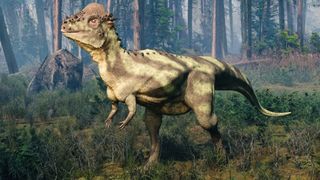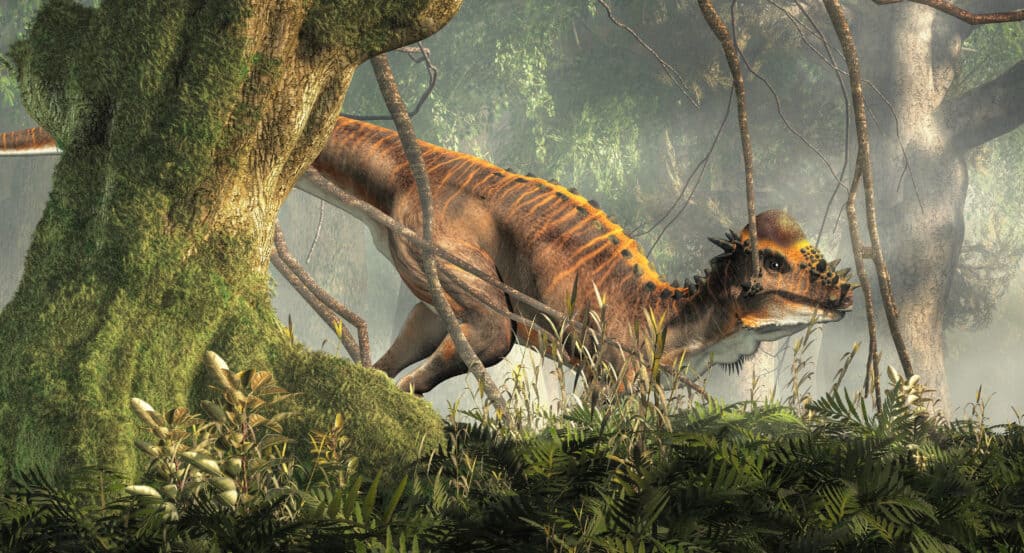Pachycephalosaurs probably didn’t butt heads at high speeds. Instead, they likely kickboxed like kangaroos.

It’s dinosaur lore that pachycephalosaurs — bipedal, Cretaceous beasts with massively thick, domed skulls — forcefully butted heads like bighorn sheep do today.
But a new analysis suggests that this is far from the case; rather, pachycephalosaurs (pack-ee-SEH’-fa-low-sawrs) may have moved more like kangaroos, using their tail as a tripod that could prop them up as they launched powerful kicks at rivals.

Paleontologists found evidence of this kickboxing behavior by analyzing a well-preserved skeleton of Pachycephalosaurus, making a virtual 3D model of it and noting that parts of the dinosaur‘s anatomy resembled those of a kangaroo and moved in strikingly similar ways.

“The skeleton in our study supports that they used their tail as a prop like kangaroos do, but not that they ran at each other and bashed their heads together like bighorn sheep [do],” Cary Woodruff, the curator of vertebrate paleontology at the Frost Museum of Science in Miami who is spearheading the research, told Live Science.

Pachycephalosaurs are the poster children for bizarre-looking dinosaurs. “They have this big bowling ball thing on top of their head,” Woodruff said. “They have these really pointy, meat-eating-dinosaur-like teeth in the front of their mouth, but they ate plants. Everything about them is weird.”

It was long thought that these Cretaceous period (145 million to 66 million years ago) weirdos ran at each other and bashed their melonheads together, possibly to compete for mates, food or territory. And while a few paleontologists have challenged this head-butting idea over the past two decades, it remains a popular concept.

Although many paleontologists have studied pachycephalosaur skulls, analysis on the rest of the body is scant because their skeletons rarely preserve well, Woodruff said. But, access to a well-preserved Pachycephalosaurus wyomingensis specimen from the Hell Creek Formation of the American West meant that Woodruff could examine its spine, as well as other anatomical features that might offer clues about its behavior.

After using a laser scanner to make a virtual 3D model of P. wyomingensis, Woodruff focused on the dinosaur’s odd back vertebrae, which had ruffled ends — almost as if someone had placed two ridged potato chips on both ends of each vertebra. These ruffles fit together perfectly, like a stack of potato chips would, Woodruff noted. Previously, paleontologists had suggested that these ruffled vertebrae helped with the head butting behavior, perhaps distributing forces from high-velocity head-butting impacts, Woodruff said.

But when Woodruff and colleagues examined the skeletons of other headbutting animals, including bighorn sheep, muskox and deer, none of them had ruffled vertebrae; however, kangaroos did.
The new study supports the hypothesis, first formulated in the 1970s, that pachycephalosaurs might have used their tail as a prop, like kangaroos do. That’s because P. wyomingensis shares several anatomical features with kangaroos — not just on its vertebrae but also its pelvis and tail.
It’s even possible that pachycephalosaurs engaged in kickboxing-like behavior. When kangaroos kickbox, they do so from a tripodal position, with the tail supporting some of their body weight. “To kickbox, a kangaroo has to first lean back on its tail, and once it’s propped up, then it can kick out,” Woodruff said.
While it’s just a hypothesis, “the possibility exists that they [pachycephalosaurs] could have engaged in their own form of a kickboxing-like behavior,” he said.

But in addition to kickboxing, did pachycephalosaurs ram their iconic heads together? If they did, it likely wasn’t at high speeds, given that their anatomy is nothing like that of ramming animals, Woodruff said. Perhaps pachycephalosaurs were more like big cows, which don’t charge each other, but do sometimes push into each other at low velocities. “If — and that’s a big if — pachycephalosaurs used their head to fight with one another,” Woodruff said, then they were likely “sumo wrestlers, not jousters.”
While this SVP presentation offered promising evidence for the dinosaurs’ kickboxing behavior, the peer-reviewed and published study will likely reveal more details, said Joseph Peterson, a paleontologist and pachycephalosaur expert at the University of Wisconsin Oshkosh who was not involved with the research. “This has the potential to really kind of change the way that we look at these particular animals,” Peterson told Live Science.

And while the findings are surprising, they simply add to the overall weirdness of pachycephalosaurs. “These are really strange animals,” Peterson said. “This adds a new dimension to it.”